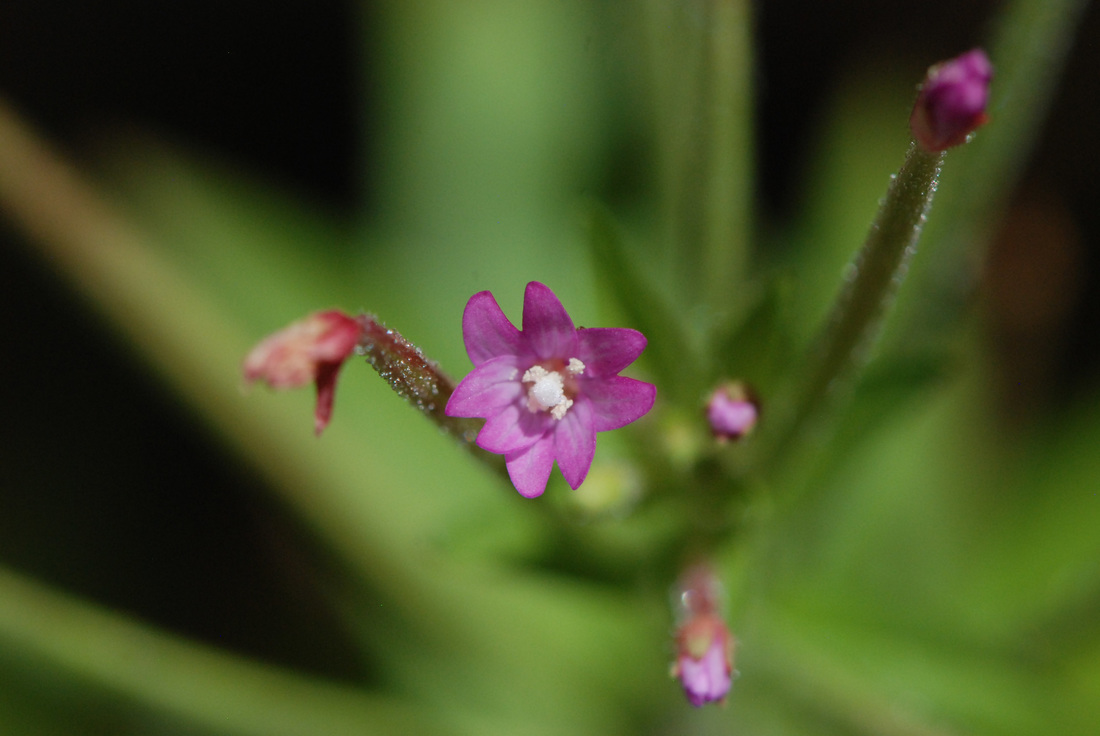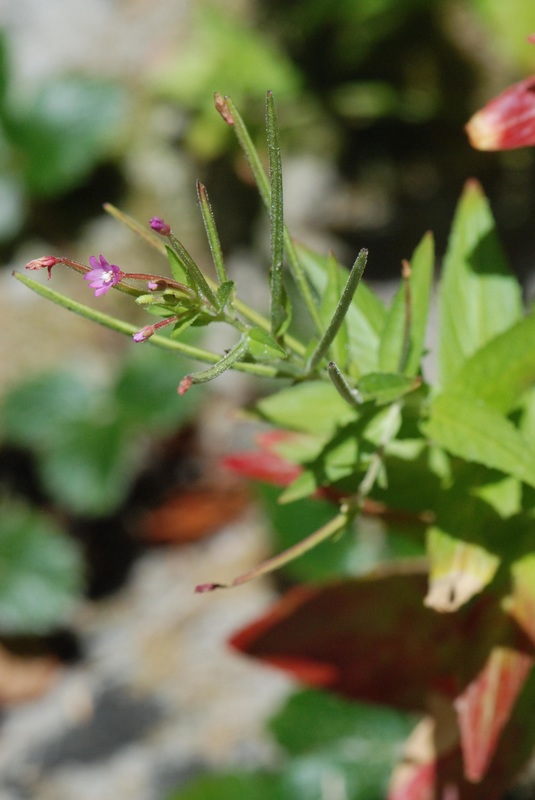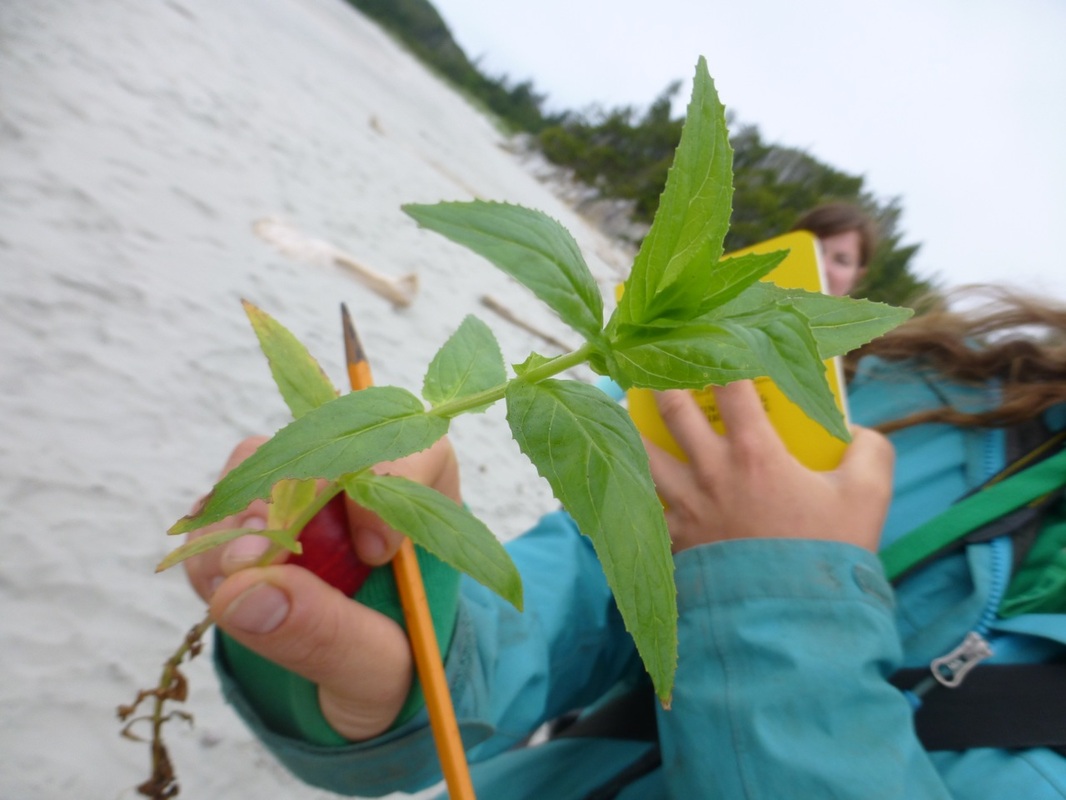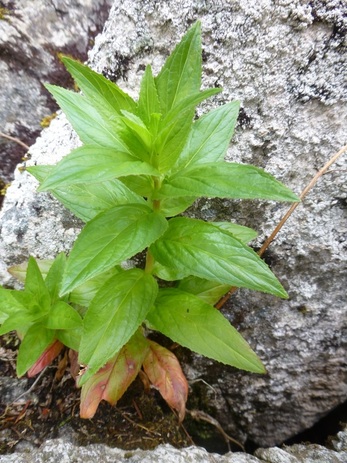Purple-leaved willowherb, northern willow-herb • Epilobium ciliatum
{Epi = upon; lobos = pod; ciliatum = fringed with hairs, a reference to the hairy to glandualar nature of the plant}
Identification
Purple-leaved willowherb is a 15-150 cm tall leafy, hairy perennial. Its lance-shaped leaves are stalkless or short-stalked, and may be finely toothed. They usually grow in opposite pairs along the stem, though they may begin to alternate at the top portion of the stem. Small pinky-purple to white flowers form clusters at the top of the stem. This plant grows from basal rosettes or bulblets.
Habitat & Range
Purple-leaved willowherb grows in wet to moist open habitats at low to middle elevations. Look for it along streams and lakes, and in meadows and thickets. It quickly establishes itself in disturbed areas such as clearcuts and roadsides; while it is a native species it is considered a weed in nurseries and other horticultural ventures. It is found throughout much of North America as well as eastern Asia.
Similar Species
E-Flora BC lists three purple-leaved willowherb subspecies; these are sometimes distinguished as individual species. Epilobium ciliatum ssp. ciliatum is the most common of the subspecies. Narrow-fruited willowherb (E. leptocarpum) is less common than purple-leaved willowherb and can be distinguished from the latter by differences in leaf and flower structure.
Purple-leaved willowherb is a 15-150 cm tall leafy, hairy perennial. Its lance-shaped leaves are stalkless or short-stalked, and may be finely toothed. They usually grow in opposite pairs along the stem, though they may begin to alternate at the top portion of the stem. Small pinky-purple to white flowers form clusters at the top of the stem. This plant grows from basal rosettes or bulblets.
Habitat & Range
Purple-leaved willowherb grows in wet to moist open habitats at low to middle elevations. Look for it along streams and lakes, and in meadows and thickets. It quickly establishes itself in disturbed areas such as clearcuts and roadsides; while it is a native species it is considered a weed in nurseries and other horticultural ventures. It is found throughout much of North America as well as eastern Asia.
Similar Species
E-Flora BC lists three purple-leaved willowherb subspecies; these are sometimes distinguished as individual species. Epilobium ciliatum ssp. ciliatum is the most common of the subspecies. Narrow-fruited willowherb (E. leptocarpum) is less common than purple-leaved willowherb and can be distinguished from the latter by differences in leaf and flower structure.
References
Atland, J. Northern-willowherb management. Weed Management in Nursery Crops. Oregon State University. Accessed 23/12/2014.
Epilobium ciliatum Raf. In Klinkenberg, Brian. (Ed.). E-Flora BC: Electronic Atlas of the Plants of British Columbia. Lab for Advanced Spatial Analysis, Department of Geography, University of British Columbia, Vancouver. Accessed 23/12/2014.
Pojar, J. and MacKinnon, A. (1994). Plants of Coastal British Columbia. Vancouver, BC: Lone Pine Publishing. P. 207.
Authors and editors of page
Kelly Fretwell and Brian Starzomski (2014).
Atland, J. Northern-willowherb management. Weed Management in Nursery Crops. Oregon State University. Accessed 23/12/2014.
Epilobium ciliatum Raf. In Klinkenberg, Brian. (Ed.). E-Flora BC: Electronic Atlas of the Plants of British Columbia. Lab for Advanced Spatial Analysis, Department of Geography, University of British Columbia, Vancouver. Accessed 23/12/2014.
Pojar, J. and MacKinnon, A. (1994). Plants of Coastal British Columbia. Vancouver, BC: Lone Pine Publishing. P. 207.
Authors and editors of page
Kelly Fretwell and Brian Starzomski (2014).







